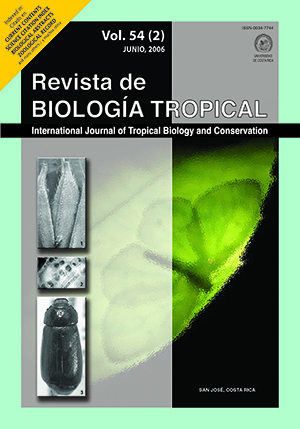Abstract
Habitat fragmentation, along with other human-induced disturbances, increase the vulnerability of native habitats to be invaded by aggressive, ecologically released, exotic species. Syzigium jambos (L.) Alston (Myrtaceae, Rose Apple) is an important invader still spreading throughout Hawaii, the Antilles, Central and South America. This study examines the effects of S. jambos on plant understory diversity in a 25 ha Tropical Premontane Moist Forest in Atenas, Alajuela, Costa Rica, a protected watershed that supplies drinking water for several human communities. Our final objective is to develop a management strategy combining water protection with the preservation of a representative sample of the original plant diversity in the area. Thirty 2 X 2 m plots were distributed throughout the Municipal Forest maintaining a minimum of 10 m between plots, and 2 m from trails, to sample all understory seedlings and saplings of S. jambos, Coffea arabica (coffee) and tree seedlings. We found a clear dominance of S. jambos over all other understory plants. Of the total 1 285 sampled plants, S. jambos comprised 51%, coffee seedlings represented 14,78%, being the rest tree seedlings. Syzigium jambos had the highest density (5.46 plants/m2, S.D. = 6.44) compared to tree (3.67 plants/ m2, S.D. = 3.44) and coffee seedlings (1.58 plants/ m2, S.D. = 2.13). There was a highly significant negative relationship between the relative abundance of S. jambos and tree (r2 = 0.52, p < 0.00001) and coffee seedlings (r2 = 0.28, p < 0.002). The abundance of coffee seedlings did not affect the abundance of tree seedlings (r2 = 0.01, p < 0.58). Since the canopy of the Municipal Forest is relatively closed and composed of a monolayer of trees with almost no overlapping crowns, we found no relationship between canopy cover and the abundance of S. jambos. The height distribution indicated that the majority of S. jambos individuals were seedlings and saplings (height ≤ 1.5 m), with only 4.6% classified as adults, (height ≥ 2 m). The results show a clear role of S. jambos as an aggressive, invasive species within the Municipal Forest. This invasion is enhanced by both the ecological characteristics of the species and the fragmentation of the forest by coffee farming around the site. Among a variety of management possibilities, an ecosystem-level approach of manually removing S. jambos over time while replanting native species appears to be the preferred strategy, given the intended continued use of the Municipal Forest as a source of drinking water and as a representative sample of the original vegetation of the area.
##plugins.facebook.comentarios##

This work is licensed under a Creative Commons Attribution 4.0 International License.
Copyright (c) 2006 Revista de Biología Tropical






